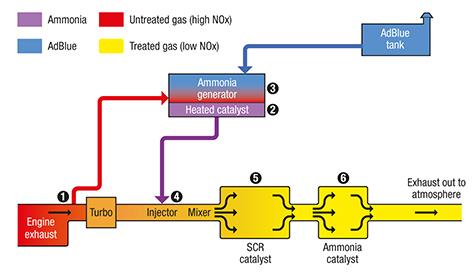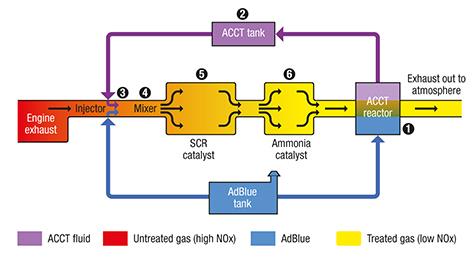The question of ‘real-life’ vehicle emissions has been thrown into sharp focus in the fallout from the VW Dieselgate scandal. While selective catalytic reduction (SCR) using AdBlue has long been accepted as the most efficient means of controlling NOx emissions from diesels across the spectrum of duty, questions remain about its effectiveness when cold.
When the technology was first introduced, low-temperature performance was not seen as a critical issue. NOx was thought to be formed only at high combustion temperatures and pressures, so cold AdBlue after-treatment would not be required.
However, it was soon realised that non-peak pressures and temperatures within the combustion chamber were indeed high enough to form NOx. At the same time, exhaust gas temperatures were not high enough for a fully-functional SCR after-treatment process, which requires temperatures of 220ºC.
AdBlue injected at too low a temperature in an attempt to control these emissions will cause problems, including urea crystal formation around the injector nozzle and the creation of a variety of deposits on the mixer unit itself. These will trigger an engine power de-rate and require expensive rectification. Besides this, the AdBlue itself will not get hot enough to liberate all of its ammonia content.
Large reductions in emissions of NOx required by Euro VI across the operational spectrum (0.4 g/kWh for heavy-duty diesels, down from 2.0 g/kWh at Euro V) forced engine manufacturers to react accordingly. Most added cooled exhaust gas recirculation to reduce NOx at combustion. The inclusion of a diesel oxidation catalyst upstream of the SCR mixer in Euro VI systems also raised exhaust stream temperatures.
But maintaining exhaust gas temperature at a level sufficient to enable SCR is still a problem, particularly on heavy-duty engines engaged in work where loads fluctuate drastically, such as city buses or off-highway construction equipment, as well as passenger cars in urban environments where low loads and speeds see exhaust temperatures drop rapidly.
One crude solution might be to burn more fuel: either by post-combustion injection or a diesel burner upstream of the SCR mixer. However, the idea of burning more diesel to clean up the air is unlikely to be popular with vehicle users or legislators.
So at least two other systems are being developed to deal with this problem.
DIAGRAM 1: B-NOx System overview

A small quantity of hot exhaust gas bled from a point upstream of the turbo (1) is used with an electrically-heated catalyst (2) to convert AdBlue into ammonia in the ammonia generator (3). This is then injected into the mixer (4) upstream of the SCR catalyst (5) to form nitrogen gas, water and CO2. Surplus ammonia is removed from the exhaust gas by the ammonia catalyst (6) prior to its output to atmosphere.
In Germany, where the banning of older diesel passenger cars from the most polluted cities is looking increasingly likely, TwintecBaumot has been touting its Next Generation B-NOx System. This bleeds off a small quantity of exhaust gas from its hottest point between the engine and the ‘hot’ side of the turbocharger, and uses it to heat the AdBlue as it passes through an ammonia generator, which is also fitted with an electrically-heated catalyst to complete the task.
The resultant ammonia is then injected into the exhaust stream between the diesel oxidation catalyst and the SCR. TwintecBaumot claims it takes just 100 seconds for a cold engine to be dosed with ammonia and for NOx control to commence after start-up. The system could be retrofitted to update older diesels to current or even future standards. However, its commercial uptake is currently on hold, thanks to the political crisis in Germany.
An alternative is the ACCT (Ammonia Creation and Conversion Technology) system being developed at Loughborough University’s Wolfson School of Mechanical and Manufacturing Engineering. This involves using waste heat from the exhaust system to pre-treat a small quantity of AdBlue in an on-exhaust reactor where pressure is controlled to prevent deposit formation. The vapourised fluid is then condensed and stored in a two-litre tank to be used when the exhaust is too cold for the normal reaction to fully take place. The ACCT fluid still has the same total ammonia content as AdBlue, but crucially, will release ammonia before the carrying fluid is vapourised when it is reheated. This means that, rather than adding to accumulated deposits, it removes them.
DIAGRAM 2: ACCT overview

AdBlue is pumped to the exhaust-mounted ACCT reactor (1), where waste heat turns it into ACCT fluid (isocyanic acid and ammonia) through thermolysis. It condenses in the ACCT tank (2) and is then added into the exhaust stream at lower exhaust temperatures (3). As the ACCT passes through the mixer (4), the isocyanic acid content undergoes hydrolysis, liberating the remaining ammonia. The ammonia then reacts with NOx in the SCR catalyst (5) to form nitrogen gas, water and CO2. Any surplus ammonia is removed by the ammonia catalyst (6). Some surplus heat is harvested from the exhaust stream to power the ACCT reactor (1) before it is ejected to atmosphere. As exhaust temperature increases, the proportion of untreated AdBlue injected directly into the mixer can be increased.
“At up to 200ºC, AdBlue will form deposits on a hot metal surface, while ACCT fluid will remove them,” explains Loughborough University research associate Jonathan Wilson. “Droplets of ACCT foam up and disperse as the ammonia boils within them: it all happens far faster than with AdBlue. Dosing can commence at gas temperatures as low as 50°C.”
On a heavy-duty diesel, the ACCT fluid will be injected when required either through its own injector or through a nozzle shared with the standard AdBlue supply, but Wilson postulates that light-duty applications will see all the required ammonia extracted from AdBlue and held on the vehicle as ACCT fluid prior to injection.
So, why don’t operators just fill up with that fluid? “It’s difficult and unpleasant to handle, because of the volatility of the ammonia content compared to AdBlue,” Wilson explains.
The programme recently won funding for a passenger car to run tests of the system (pictured in the lab, above).
In future, Wilson sees any further legislation aimed at reducing total diesel NOx emissions as depending upon a technical solution that is competent at all exhaust temperatures.
THE CHEMISTRY
AdBlue is a solution of 32.5% urea and 67.5% water (by weight). It is a relatively safe and convenient means of storing and transporting ammonia, which is toxic and corrosive. When AdBlue is injected into a hot exhaust stream, the water evaporates and, at temperatures of over 133ºC, the urea starts to decompose into ammonia and isocyanic acid. This process is thermolysis (molecular breakdown by heat). Half the ammonia in a given quantity of AdBlue is released by this process. After thermolysis, the isocyanic acid is broken down by water, turning it into CO2 and ammonia.
So, both stages of the decomposition process must be completed, if the ammonia content of the AdBlue is to be fully released. If only the first stage is completed, then the isocyanic acid will react to form solid deposits on the internal surfaces of the SCR system, including ammelide, ammeline and melamine. (In conventional systems, isocyanic acid is broken down by the SCR catalyst, but this process takes up valuable space on the catalyst’s surface and may impair the NOx conversion process.)
Loughborough’s ACCT fluid is AdBlue that has undergone thermolysis in a reactor (which is mounted on the engine’s exhaust system and harvests waste heat) and then condensed and stored in liquid form prior to injection into the AdBlue mixer upstream of the SCR catalyst.